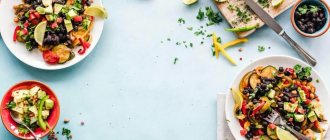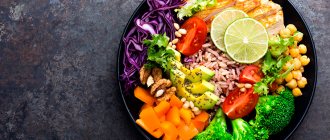Nutrition must be adapted to the person’s health status. Various diseases affect the biological processes in the body, so it is necessary to change the need for nutrients. Diet programs are used to achieve these changes. Diet is an integral part of therapeutic nutrition prescribed by a doctor, affecting the course of the disease, recovery, elimination of obesity and excess body weight.
A real diet is a special diet and eating regimen
So, all of the above has a very indirect relationship to this diet. A diet is a diet specially selected for its chemical composition, energy value (calorie content), method of heat treatment (or lack thereof) and, of course, a certain diet. But it must be emphasized that diet translated from Greek is a way of life. This means that it’s not enough to chew cabbage for a few weeks, wincing, you’ll have to reconsider your eating habits and stick to a new diet for the rest of your life, only then will the diet be effective and healthy.
Diet and healthy eating are two different things
Thanks to marketing, advertising, and the Internet, diet began to be perceived differently. If you ask different people “What is a diet?”, then everyone will answer you that this is some kind of restriction. Indeed, in the understanding of ordinary people, a diet is a nutritional system based on restrictions for a specific purpose. In most cases, this goal is weight loss, which involves losing weight by selecting a certain type of diet.
Today there are many known diets - Mediterranean, protein, various mono-diets: buckwheat, kefir, green, based on eating green foods, watermelon, original diets. The latter include a diet shared with an audience by a famous person who has lost weight. He writes books and reveals his weight loss secrets on social networks. And people begin to adhere to the same food system that their idol offers them. Unfortunately, the recipe for slimness may not work for everyone.
A diet as a “food system” does not teach health and does not provide an understanding of how to eat in the future. Only one task is set for her - short-term weight loss (in more rare cases - weight gain).
The exception is diets for medical reasons. They are prescribed for diseases of the gastrointestinal tract - exacerbations of gastritis, pancreatitis, as well as allergic reactions. Then we exclude allergenic foods from the diet.
The trendy gluten-free diet doesn't help you lose weight. It is specially designed for people with celiac disease - gluten intolerance. In this case, we remove all dishes containing wheat, rye, and barley.
Side effects
Before going on a diet, consult your doctor. By limiting yourself in many foods (especially on mono-diets), you do not receive enough useful micro- and macroelements. By removing fats from their diet, girls risk developing amenorrhea - absence of menstruation. Because it is from fats that the hormones of the female reproductive system (estrogen and progesterone) are formed.
Healthy eating
Healthy eating is a change in human nutrition culture. Its main difference from a diet is that such nutrition is developed for life. If we say “give up sweets and trans fats for a month - you will lose weight,” then we mean diet. If we remove the time indication from the sentence, we get healthy nutrition.
The doctor will always explain to the client the mistakes he makes when consuming foods. For example, does he have an excess of simple and fast carbohydrates? Instead of eating complex carbohydrates (cereals), he constantly snacks on sweets (cookies, candies, pies), the person experiences sharp surges in blood sugar, insulin surges, and then hunger sets in again. This is an unhealthy or carbohydrate type of diet.
If we limit sweets, allow ourselves fruit instead of refined sugar for snacks, plan the menu for breakfast, lunch and dinner for a long time, as a result we radically change our habits. This does not mean that everything sweet and starchy is prohibited; we only reduce it in our diet. You can follow the rules by periodically taking “a step to the right, a step to the left,” and sometimes eating something forbidden. But don’t forget the path of healthy eating. When we “sit” on healthy foods for a while and then start eating everything in a row, this is a diet.
Another difference: healthy eating is an integral part of a healthy lifestyle. A healthy lifestyle is a set of measures aimed at preventing diseases and signs of aging. It necessarily includes physical and mental activity, anti-stress therapy and, of course, healthy eating. Therefore, it is impossible to consider one or another element of a healthy lifestyle separately.
For example, according to the rules of nutrition, you need to go to bed before 12 o'clock at night. It is at this time that growth hormone is produced, which improves our protein metabolism and stimulates additional fat burning.
Physical activity without nutritional adjustments may not lead to the ultimate goal - health. Therefore, be sure to move at least 30 minutes every day.
As a nutritionist, I always discuss with clients their lifestyle, food culture, and only then make recommendations, rather than “putting” them on a diet.
How do you know when it’s time to start changing your food culture? According to waist size. If for girls it is more than 80 cm, and for men it is 94 cm for men. Regularly undergo medical examination and do a biochemical blood test. If there are predisposing factors to any diseases (for example, diabetes mellitus - lack of physical activity, an increase in the hormone insulin in the blood, or a slight increase in fasting sugar), it’s time to think about changing your diet and lifestyle.
Evaluate your nutrition today. Keep a diary in which you write down everything you ate with KBZHU. If fast and simple carbohydrates prevail during the day - potatoes, couscous, cookies, flour products, you should think about adjusting the menu.
Reducing body fat mass while maintaining a healthy diet is not an end in itself. The goal is to maintain health, and weight loss happens naturally.
Selection of diet, taking into account the individual characteristics of the body
On the other hand: you won’t starve forever? That is why you need to choose a diet not following fashion trends, but taking into account the individual characteristics of the body. And a nutritionist will help with this.
If you stay on a diet for a couple of weeks or months and then “fall off”, then the lost kilograms will quickly return. Sometimes even in excess. Such “swings” harm your figure (stretch marks appear) and your health. Therefore, you need to choose for yourself the gastronomic lifestyle with which you will be comfortable living for a long time without harm to your well-being. The exception is those diets that are used for minor adjustments of metabolism, minor weight loss, etc. (although they can also be designed for a long time).
Meaning of the word diet
..., black tea, all soda drinks. Diet for blood type 3 Mixed diet (balanced... Avoid: tomato juice, soda drinks. Diet for blood type 4 For people with blood type 4, a moderate mixed diet is suitable. Good: meat (lamb, rabbit , turkey …
In general, the number system of diets looks like this: • Diet No. 0 - postoperative; • Diet No. 1, No. 1a, No. 1b - peptic ulcer ... of the stomach and duodenum; • Diet No. 2 - chronic gastritis, acute gastritis, enteritis ... and colitis, chronic enterocolitis;• diet No. 3 – constipation;• diet No. 4, No. 4a, No. 4b, No. 4c – diseases of the intestines with diarrhea;• diet No. 5, No. 5a – diseases of the liver and biliary tract...;• diet No. 6 - gout, urolithiasis with the formation of stones ... and chronic nephritis (pyelonephritis, glomerulonephritis); • Diet No. 8 - obesity; • Diet No. 9 - diabetes mellitus; • Diet No. 10 - diseases of the cardiovascular ... system with circulatory failure; • diet No. 11 - tuberculosis; • diet ... No. 12 - functional diseases of the nervous system; • diet No. 13 ... - acute infectious diseases; • diet No. 14 - kidney stones ... stones consisting mainly of oxalates; • diet No. 15 - various diseases that do not require... special diets. The system of numbered therapeutic diets is currently used...
The recommendations given in the book will make the menu for tube diets more varied. In addition, the following types of diets are presented: fasting diets; Carrel diet (prescribed for circulatory failure of II–III degree); potassium diet; magnesium diet. The book is addressed to the widest readership. Recommended for readers over 12 years old.ruru
You know what methods I'm talking about: the "cookie diet", the mustard diet, the "eat whatever you want for one hour a day" diet, eating cabbage soup, the "part-time" diet (one day on a diet, the next - free), grapefruit diet, eating baby food, liquid diet, juice detox diet, eating coconut oil, peanuts, ice cubes[6], ice cream, grapes, pizza, caveman diet, drinking red wine, one-day, three-day and seven-day diets and even tapeworm (yes, some people are really willing to swallow tapeworm just to lose weight).
Duration of the diet is 6 days. Kefir diet 31 days: 5 boiled potatoes and 1.5 liters of kefir. 2 day: 100 g of boiled chicken and 1.5 liters of kefir. 3 day: 100 g of boiled meat and 1.5 liters of kefir.4 day: 100 g of boiled fish and 1.5 liters of kefir. 5 day: fruits and vegetables, except bananas and grapes, plus 1.5 liters of kefir. 6 day: only kefir. 7 day: mineral water. Eat nothing else these days it is impossible, and the above-mentioned foods must be prepared and eaten without sugar and salt. The diet can be repeated no earlier than after a month, preferably after two. Striped kefir diet The striped diet is easily tolerated.
Viktor Aleksandrovich KonyshevFood without harm: The ABC of nutrition Viktor Aleksandrovich Konyshev is a doctor of medical sciences, a nutrition specialist, the author of the books “The Famous Kremlin Diet”, “The Love Diet” and other popular books about food and diets. A well-known and very experienced nutrition specialist has compiled a real dictionary for you -guide.
People who adhere to diets that allow them to consume fatty foods in unlimited quantities (Kremlin diet, Atkins diet, American astronaut diet, glasses diet, etc.)
For people who are overweight, a nutritionist can recommend an ovolacto-vegetarian diet. In the practice of dietary treatment of excess weight, it has been found that one-day fasting helps some patients, while others benefit from the Mediterranean diet, yogi diet, Dr. Atkins diet or the “Kremlin” diet. Compliance with fasts, subject to good health tolerance by the body, can contribute to slimness and getting rid of excess weight. You will read about all this on the pages of our book. To lose weight = to look younger To lose weight - to become thin, to lose weight, to lose some obesity, fullness.
In the future, with positive dynamics of pain and dyspeptic syndromes (absence of nausea, belching, heartburn), diet 1d, which differs little from diet 1b, is recommended for 1–2 weeks and diet 1, which patients with chronic gastritis should adhere to for several months. Diet 1 This diet retains the principle of chemical sparing of the mucous membrane of the upper digestive tract, but compared to those previously described, it consists of a more diverse range of products and dishes.
At first, I copied diets from friends in which foods were listed literally by gram (Mayo Clinic diet, Scarsdale diet, Atkins diet, Montignac diet, etc.).
Sources
- Röhe I., Vahjen W., Metzger F., Zentek J. Effect of a “diluted” diet containing 10% lignocellulose on the gastrointestinal tract, intestinal microbiota, and excreta characteristics of dual purpose laying hens. // Poult Sci - 2021 - Vol99 - N1 - p.310-319; PMID:32416816
- Kreuzer M., Müller S., Mazzolini L., Messikommer RE., Gangnat IDM. Are dual-purpose and male layer chickens more resilient against a low-protein-low-soybean diet than slow-growing broilers? // Br Poult Sci - 2021 - Vol61 - N1 - p.33-42; PMID:31550927
- Röhe I., Vahjen W., Metzger F., Zentek J. Effect of a “diluted” diet containing 10% lignocellulose on the gastrointestinal tract, intestinal microbiota, and excreta characteristics of dual purpose laying hens. // Poult Sci - 2021 - Vol - NNULL - p.; PMID:31504865
- Röhe I., Urban J., Dijkslag A., Te Paske J., Zentek J. Impact of an energy- and nutrient-reduced diet containing 10% lignocellulose on animal performance, body composition and egg quality of dual purpose laying hens. // Arch Anim Nutr - 2021 - Vol73 - N1 - p.1-17; PMID:30545247
Diet - what is it (therapeutic diets, diets for weight loss)?
“Diet (from the Greek diaita, Δίαιτα) is the controlled consumption of food and liquid, aimed at achieving a specific goal. The term “diet” can be used in several different ways: hospital (official) diets, programs for losing weight, maintaining or changing health, long-term dietary systems (supported by a lifestyle or philosophy).” This is how the wiki describes the diet (Wikipedia.org).
Principles of dietary nutrition:
- use of high-quality raw materials;
- reduction of heat treatment of products;
- reducing the consumption of hot spices;
- increasing the consumption of greens (dill, parsley, lemon instead of vinegar);
- depending on the disease - increase/decrease of certain nutrients;
- regular meals (5 times a day, for diabetes - 6 times a day);
- emphasis on the taste of food - increasing appetite in patients.
Diet is a broad concept. The dietary program as such does not imply hunger or sudden changes leading to deterioration of the condition.
Notes[ | ]
- Town Hall, 2021.
- Lopez-Moreno, J.
Dietary fat quantity and quality modifies advanced glycation end products metabolism in patients with metabolic syndrome: [English] / J. Lopez-Moreno, GM Quintana-Navarro, A. Camargo ... [et al.] // Molecular Nutrition & Food Research. — 2021. — 24 February. — ISSN 1613-4133. - doi:10.1002/mnfr.201601029. - PMID 28233454. - ↑ 1234
Marton et al., 2021. - Woolf, 2021, Chapter “Hunger”, p. 263-296.
Literature[ | ]
Diet:
- Meanings in Wiktionary
- Media files on Wikimedia Commons
- Marton, RM
Science, advocacy, and quackery in nutritional books : an analysis of conflicting advice and purported claims of nutritional best-sellers : [English] : [arch. August 18, 2020] / RM Marton, X. Wang, AL Barabási ... // Palgrave Communications: journal. — 2021. — Art. 43. - doi:10.1057/s41599-020-0415-6. - Ratushny, A. S.
Dietary nutrition // Everything about food from A to Z: Encyclopedia. - M.: Dashkov and K°, 2021. - P. 120-133. — 440 s. — 300 copies. — ISBN 978-5-394-02484-9. - Naomi Fulf.
The myth of beauty. Stereotypes against women = Wolf Naomi. The Beauty Myth: How Images of Beauty Are Used Against Women. - M.: Alpina non-fiction, 2021. - ISBN 978-5-00139-024-4..
Diet therapy[ | ]
Main articles: Diet therapy
and
Dietary nutrition
Personalized dietary therapy allows you to select therapeutic nutrition taking into account the patient’s current medical history, the pathogenesis of the disease and the treatment he is undergoing. A therapeutic diet can be either the main or, more often, an auxiliary therapeutic method [1].
For example, in patients with metabolic syndrome, a diet with a high proportion of monounsaturated fatty acids leads to a decrease in the amount of advanced glycation end products and reduces symptoms of the disease[2]
Restrictive diets
In a diet based on such diets, there is a bias in favor of some organic substances. Examples of such diets are the now very common protein, or low-carbohydrate, low-fat, and even fat diets. Perhaps the healthiest among them are low-fat diets. Indeed, fat calories are more easily converted into excess weight than those obtained from other sources. When creating such a diet, it is necessary to remember that the deficiency, first of all, should apply to fats, and only then to carbohydrates. A homemade diet may well be based on this principle, since it is inexpensive and uncomplicated.
DIET translation
The Salerno Medical School became the most famous medical institution not only in Italy, but throughout Western Europe. It was written in the fourteenth century by the philosopher and physician Arnold of Villanova. The secret of longevity lies in a rational regimen: moderate food, avoidance of excessive wine, reasonable use of sleep and wakefulness, movement and rest. By observing it, a person can live as many years as nature intended for him, that is, much more than he actually lives.
Content
In therapy, the author of the Salerno Code of Health, Arnold, steadily adhered to hippocratic principles. He considered the main task of a doctor, in addition to a comprehensive study of local phenomena, to be the individualization of each particular case. For long-term illnesses, Arnold advised changing places, traveling and treatment with mineral springs.
But the most important thing is diet.
You can upload your video to our Videoreka website. If you want to insert a video from Youtube, to do this, click the “Share” link under the video, select the “HTML code” option, copy it and paste it into the form below. To add this video to your article, copy and paste the following code where you want it in the text. Life rushes through potholes: That’s a deuce”;..
Healthy diets
These diets are not as strict in their indications as therapeutic ones. Their main task is to restore strength after stress or heavy physical activity, increase tone, and cleanse the body. As a rule, healthy nutrition is used in combination with other strengthening and cleansing procedures. A healthy diet is the use of natural products, the exclusion of food additives, canned food, and fast food.
Why is our belly growing?
Now let’s take a closer look at why women’s stomachs become rounded and it is very difficult to get rid of fat mass in this particular part of the body. The question especially begins to worry around the age of 26 and beyond. Moreover, the problem occurs not only among those who already have the good fortune of being a mother, but also among those who have not given birth. The whole point lies in our direct, natural destiny - motherhood.
- To prevent the embryo from suffering from injuries, nature creates a protective barrier. And even if a woman is not pregnant, the period of motherhood laid down in the genes begins, which means that the body works according to a natural schedule and accumulates a layer of protective fat in this place.
- The second reason is that when carrying a child, the muscles become stretched and they cease to be firm and elastic. And, despite the fact that approximately six months after delivery they seem to “get involved,” the predisposition still remains. With the slightest weight gain and loss of appetite control, the stomach will begin to round. Probably many of us were surprised by this phenomenon - a thin lady, with chiseled legs, seemingly skin and bones. But no, the tummy still sticks out. All these are consequences of childbirth and the natural position of a woman’s reproductive body.
Types of gout
Gout can be primary or secondary .
Primary gout is inherited and is associated with insufficient function of enzymes involved in regulating uric acid levels.
Secondary gout develops against the background of an existing disease, in which, for one reason or another, there is an increased formation of uric acid, for example, in blood diseases or chronic kidney diseases. In such cases, treatment should be aimed at treating the disease that led to the development of secondary gout.
The following indicators of uric acid levels in the blood are considered normal:
- in men under 60 years old - 250-450 µmol / l; over 60 years old - 250-480 µmol/l;
- in women under 60 years old - 240-340 µmol/l; at an older age – 210-430 µmol/l;
- in children under 12 years of age – 120-330 µmol/l.
Exceeding these indicators indicates a violation of uric acid metabolism and an increased risk of developing symptoms characteristic of gout. In such a situation, it is necessary to undergo an examination to clarify the cause of this disorder, as well as timely identification of diseases leading to increased levels of uric acid. Early detection of such underlying diseases in some cases allows timely treatment to be started and life-threatening complications to be avoided. With prolonged disruption of uric acid metabolism with increased excretion in the urine, urolithiasis inevitably develops and, ultimately, renal failure.
Diet in culture[ | ]
In society, the concept of diet is most often limited to a “diet for weight loss”; many authors, usually not professional nutritionists, distribute a variety of diets and practices based on them aimed at reducing excess body weight and combating obesity. One hundred global bestsellers on diets have 83 authors, of which 80 authors offer readers diets for weight loss. Only five authors out of 83 are related to nutrition. Other authors include entrepreneurs, actors, bloggers, and people from other professions unrelated to medicine, including a fireman and a billiards player. Only about a third of the authors have a medical education and work or have worked in medicine; about half not only do not have a scientific degree, they do not even have a higher education. In total, only 20 of the 83 authors are enrolled in universities, including outside the state (eng. adjunct, voluntary)[3].
Very few of the authors of these books have scientific publications in peer-reviewed journals, and often these publications were retracted after independent scientific criticism (one of the authors had all 28 papers retracted). One of the authors received warnings from the regulatory authority (FDA), another was deprived of the right to practice medicine for disseminating “controversial” treatments, the third was convicted and is serving a sentence in prison[3].
Different authors of best-selling diet books offer readers opposing methods for the same thing - combating excess body weight (obesity). Some authors popularize the so-called “functional medicine,” which does not have a uniform definition and is a variant of alternative medicine[3].
All this, as well as reviews from experts, indicate the unscientific nature of the diets set out in the vast majority of popular books[3].
Among young upper-class women in Western countries, caloric restriction has become widespread for social reasons. This behavior can pose serious health risks[4].









